People
Is Loïc Gouzer the Federer of the Art Market? A Q&A With the Irrepressible Christie’s Maverick Who Sold ‘Salvator Mundi’
We speak to the man behind the record-shattering $450 million sale about his unique approach to the auction game.
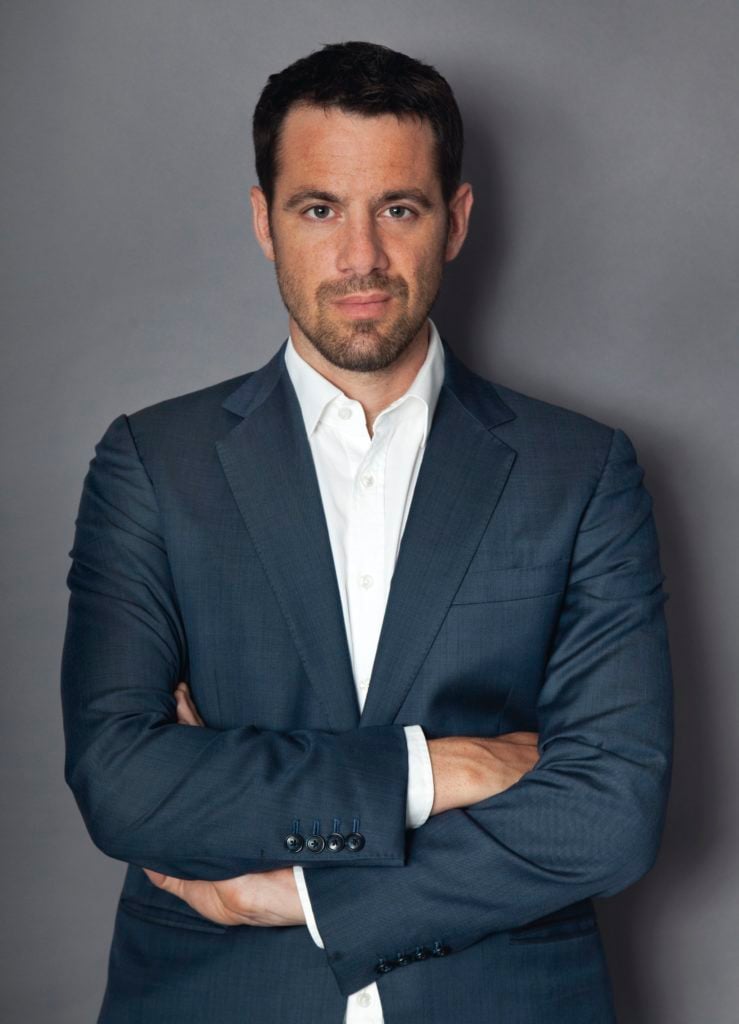
We speak to the man behind the record-shattering $450 million sale about his unique approach to the auction game.

Andrew Goldstein

When the hammer came down on Leonardo da Vinci’s Salvator Mundi at Christie’s postwar and contemporary sale last November, setting the world record by leaps and bounds for a work of art at auction, a reverent sense of awe briefly descended upon the jaded art world. But while it may have seemed miraculous, the sale had a decidedly earthly origin.
Standing nearby with a wolfish grin, Loïc Gouzer—the specialist who managed to bring the masterpiece to sale through a combination of chutzpah and Luciferian energy, and who approaches auctioneering as a high-stakes sport—was already planning the next play. The goalposts had simply been moved back further than ever before.
Gouzer’s title at Christie’s is technically co-chair of the postwar and contemporary art department for the Americas, but it might be more apt to view the 38-year-old Swiss dynamo as the auction house’s chief innovation officer. Since joining Christie’s in 2011, he has repeatedly broken new ground by bending the rules, first gaining attention for the standalone “If I Live I’ll See You Tuesday…” auction in 2014—a curated mix of edgy work from across generations, with Richard Prince’s infamous Spiritual America as its centerpiece—that he advertised with a skateboarding video.
He pushed the envelope further with auctions like “Looking Forward to the Past” in 2015, raising eyebrows by presenting a painting by Monet alongside work by present-day stars like Peter Doig, bracketing the whole sale between erotic works by Marcel Duchamp and Prince. Including the Leonardo in the contemporary sale was just the latest expression of this strategy—which, along the way, set the world record for an artwork at auction not once but twice, and in succession.
An avid sportsman who is known to swim with sharks and enjoy spearfishing, Gouzer is also a dedicated supporter of environmental causes, sitting on the board of the conservation nonprofit Oceana and collaborating with his famous friends and contacts to raise money for ecological initiatives. (A charity auction that he assembled with Leonardo DiCaprio in 2013 raised $38.8 million for a variety of conservation projects.) It is a pursuit that he effectively evangelizes both in person and on his widely followed Instagram account, where a steady stream of high-priced artworks are punctuated by images of endangered animals.
As for the art market, now that the Leonardo sale is history, what’s the next challenge? For the first installment of a two-part interview, artnet News’s Andrew Goldstein spoke to the specialist about his own evolving role and the biggest opportunities in the auction game.
You are nominally one of the heads of Christie’s postwar and contemporary department, but your actual activities range quite widely beyond that. You were also involved in the Rockefeller sales and the Impressionist and Modern sales this year, for instance. How would you describe your ambit?
I think in every company you get boxed into a container, and of course there are artificial divisions between spheres of art, which are not always relevant to collectors. But I don’t really care which period or area of the world it comes from. For me, the way art is divided is in terms of quality, from one to 10, with 10 being the best, basically. I’ve always functioned like that, so I’ve always worked across departments, looking at design, African art, and other areas, not only postwar and contemporary art.
If you were to play back the reel of the most recent slate of auctions, as if it were a soccer match, is there anything that you would have done differently?
I don’t think there’s anything I would have changed. Well, I would have preferred that Picasso’s The Sailor [a painting estimated to sell in the range of $70 million that had been consigned by Steve Wynn but was withdrawn in the eleventh hour after a pole reportedly fell on it] had not sustained a little damage, because that was something I worked on very hard, and I really, really liked the work. Being in the art market, we are often portrayed as only caring about numbers, but we actually care about the artworks also.
Beyond that, I think the sales went very well. There was always a question mark—whether the market collectors could absorb so much work coming at the same time. But it did.
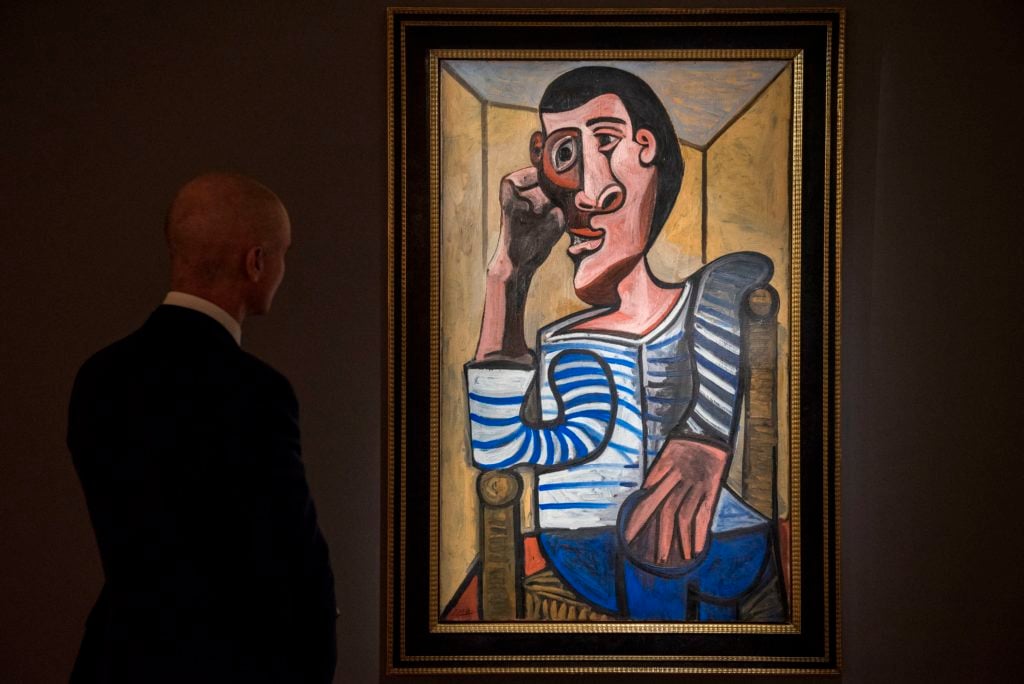
Pablo Picasso’s Le Marin (aka The Sailor) at Christie’s, before the contretemps. Photo: PHILIP FONG/AFP/Getty Images
After The Sailor was pulled, another Picasso also reportedly consigned by Wynn and estimated to sell for $35 million was also withdrawn. If those Picassos hadn’t been taken out, do you think it could have been Christie’s best season ever?
I don’t know. I always forget the numbers. I’m really a paintings guy, so I remember the prices of individual paintings and all that. But if you ask me the total of the sale last year, I couldn’t tell you—I remember for five minutes, and then I forget. Once it happens, it happens, so it’s no longer really relevant. What is relevant is always what’s going to happen next.
Obviously, you have a more relaxed approach to the high-wire market environment than your typical career specialist. How would you describe your actual role within Christie’s?
It’s no secret that I have trouble with structure and corporations. But, at the same time, I like to use this big machinery to do experiments. I always say sometimes that I find Christie’s—or auction houses in general—to be like a big piano where if you press one key it will be a success. And if you press another key, then you’re going to have people saying, “What the hell were you thinking?” There’s just something a bit playful about the piano that is an auction house.
I’m co-chairman of postwar and contemporary art in partnership with Alex Rotter, and we work very differently but in a very complementary manner. He always says that I’m the quarterback, and he’s the coach. I come up with a lot of ideas and concepts and focus on specific targets, and Alex is the one who has a broader, 360-degree view. I don’t want to say I’m a lone wolf, because I work on things with everyone, but I would say I have a longish leash.
You compare Christie’s to a piano, and I think it’s safe to say that they’ve never seen a piano player like you before. Because when you came to Christie’s in 2011—after four years at Sotheby’s—it was a very different era. How would you describe the auction house when you first got there?
It was still very much a business that was reliant on the three ‘D’s—works of art coming your way because of death, debt, or divorce. Now, it’s come to the point where most of the artworks that we see at auction are not the result of a phone call from a client to a specialist, but instead the result of a phone call from a crazy specialist to a client. It all became much more proactive. I was part of that generation that first decided to shake the coconut tree and see what falls rather than waiting under the coconut tree to pick up what fell on the sand. The best sales happen when we have a vision and we can convince people to trust us.
The other thing I would say, to some degree, is that auction specialists are now able to impress their vision of art on the market at a broader level. And that’s what is really exciting about the whole thing, as opposed to before when we would just sell the works that would come on the market.
To put it another way, you can now use an auction to create taste, rather than simply to reflect older taste.
Yes, when you’re in an auction house and you love something, it’s very difficult to resist the temptation to promote your vision like any gallerist would do. So if you’re a specialist who likes Minimalism, for instance, of course you would go after great Minimalist work to show the world that Donald Judd and Ad Reinhardt deserve credibility in the market. Or you have specialists like Sara Friedlander [Christie’s international director and head of postwar and contemporary art], who is very passionate about female artists. Of course, auction houses are not museums, and we’re not curators. But we still have a responsibility to at least try to show art that is relevant, important, and that will last, because auction houses are the gate of arrival for many new collectors from around the world.
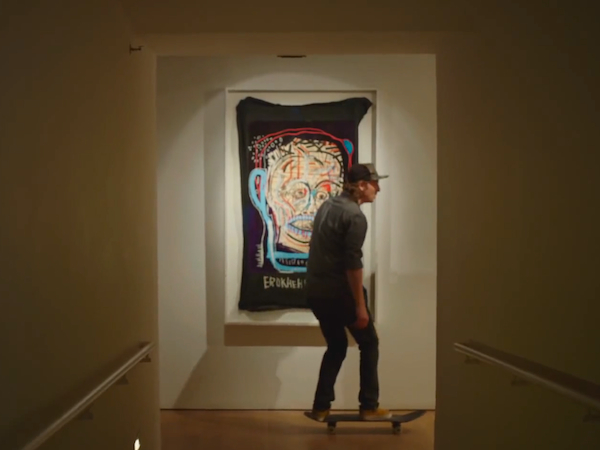
A still from the video for Christie’s ” If I Live I’ll See You Tuesday…” video.
Via YouTube.
It’s interesting you talk about imposing taste, because the special standalone sales that you have become known for range widely in terms of the work that is shown. In fact, one tactic that you very frequently employ to great effect is juxtaposition, where you surprise the audience by placing a work by an edgy young artist next to a major Warhol, as you did with the then-still-rising star Alex Israel in “If I Live I’ll See You Tuesday…,” boosting him to break $1 million for the first time. This kind of irreverent juxtaposition—like using a skateboarding video to promote an art auction, or putting a 500-year-old masterpiece by Leonardo da Vinci in a postwar and contemporary sale—has been enormously successful in creating a frisson of excitement around your auctions. Was that your plan from the beginning, to shake things up by sticking together incongruous artworks at wildly different price points?
When I came to New York as a kid, maybe I was a little bit cocky or naïve, but I really believed that the only way to succeed was to try to bend the rules—not the rules of legality, but the rules of the customs and traditions.
I like that auctioneering is one of the oldest jobs in the world. There have been people auctioning almost everything, from cattle to coins, for almost as long as mankind has existed, and it hasn’t really changed. If you compare it to sports, tennis has been the same game for I don’t know how many hundreds of years, but tennis players have kept on reinventing the game. I’m no Federer, but I try to reinvent the game as much as possible within the boundaries of the art-market tennis court.
Is Federer the athlete that you aspire to the most, in terms of his smooth, effortless style of play and long record of dominance?
Federer is Swiss, like me, and he’s also a friend, and he’s also a hero. He’s someone who has successfully reinvented tennis each time he’s played. I look at sports the most for inspiration—tennis players and soccer coaches and people like that.
But none of us are doing brain surgery or heart surgery here, so the innovations we introduce are not changing the world. That’s why when I’m off the court, to keep with the metaphor, I try to do as much environmental work as possible by leveraging the power and the wealth of the art market and the contacts I have to see if I can make the planet and the oceans a better place. It’s not an easy task, but I think all of us—perhaps including you—look at our day jobs and sometimes wonder whether what are we doing is actually good for the world. For me, disruption of the planet is the biggest crisis of our time, and I find it difficult—being a guy who’s able to sell a $50 million painting here and a $50 million painting there—not to try to get funding from some of the same people for conservation projects.
A post shared by Loic Gouzer (@loicgouzer) on
Recently, right after the auctions ended, you posted on Instagram an infographic about the decimation of elephants and black rhinos in Africa. In other posts you’ve referred to these endangered animals as “masterpieces” themselves. It’s a powerful sentiment.
As much as I was happy when the da Vinci sold, the second the hammer fell—and, again, maybe it’s all too naïve and stupid—I couldn’t help but think, “What if that $450 million was used to save an entire dying ecosystem in Indonesia, or to create a giant marine park?” I see all the possibilities of what that kind of money could do. I think it’s great that people like art, and I think it’s great that there are museums being built to keep it protected and safe and displayed for future generations. I just wish that even one-tenth of the money was spent on preserving the masterpieces of nature, basically. Even though we’re used to working with big numbers and very wealthy people, it’s still difficult to fathom those sums in the context of what’s going on in the world.
When you mention $450 million, you’re of course referring to the sale of Leonardo’s Salvator Mundi, which astounded the world by bringing in the highest price ever seen at auction. It is a phenomenon that illustrated just how much power record-breaking sales of art have to galvanize world attention, possibly in part because of how out of whack with reality they seem. At the same time, the context of the sale—that it was a haunting, supernatural-seeming portrait of the Christian savior by the world’s most legendary Renaissance genius, placed in the surreally incongruous context of a megawatt evening auction of contemporary art—made it a moment of high drama. Your bringing it to Christie’s could be seen as a career-defining coup. Tell me the story about how Salvator Mundi came into your life.
A lot of people say it’s my crowning achievement, but in my book, there are successes that I’m much more proud of from my environmental work, even if no one cares about those.
But in terms of my business, the one success that I consider my biggest achievement is actually the sale called “Looking Forward to the Past” [from May 2015]. Because the da Vinci was a big operation, but it was one painting. “Looking Forward to the Past” was something that I had to put together when I was still fresh off the boat, as they say, and I didn’t have much cred or a network of people who knew me. I put that sale together from a blank page.
I was lucky that I got support from [Christie’s owner] François Pinault and the board to go ahead with what at the time was considered a crazy idea, to do a curated sale of both contemporary and Impressionist art. And with that sale I got the world record for a Picasso [$179.4 million for Les femmes d’Alger (Version ‘O’), 1955]—it was actually the previous world record for a painting before the da Vinci—and I also got the record for the most expensive sculpture with the Giacometti.
That sale repositioned Impressionist and Modern art on the collecting map like no other sale had ever done. Before that, Impressionist and Modern art had been trailing behind contemporary for a few years, and I think people need to realize that there’s great quality art from that period that deserves as much limelight as the Warhols and Basquiats of this world. So for me this was the biggest achievement, because it was such a huge project to do, to do a sale like this by yourself.
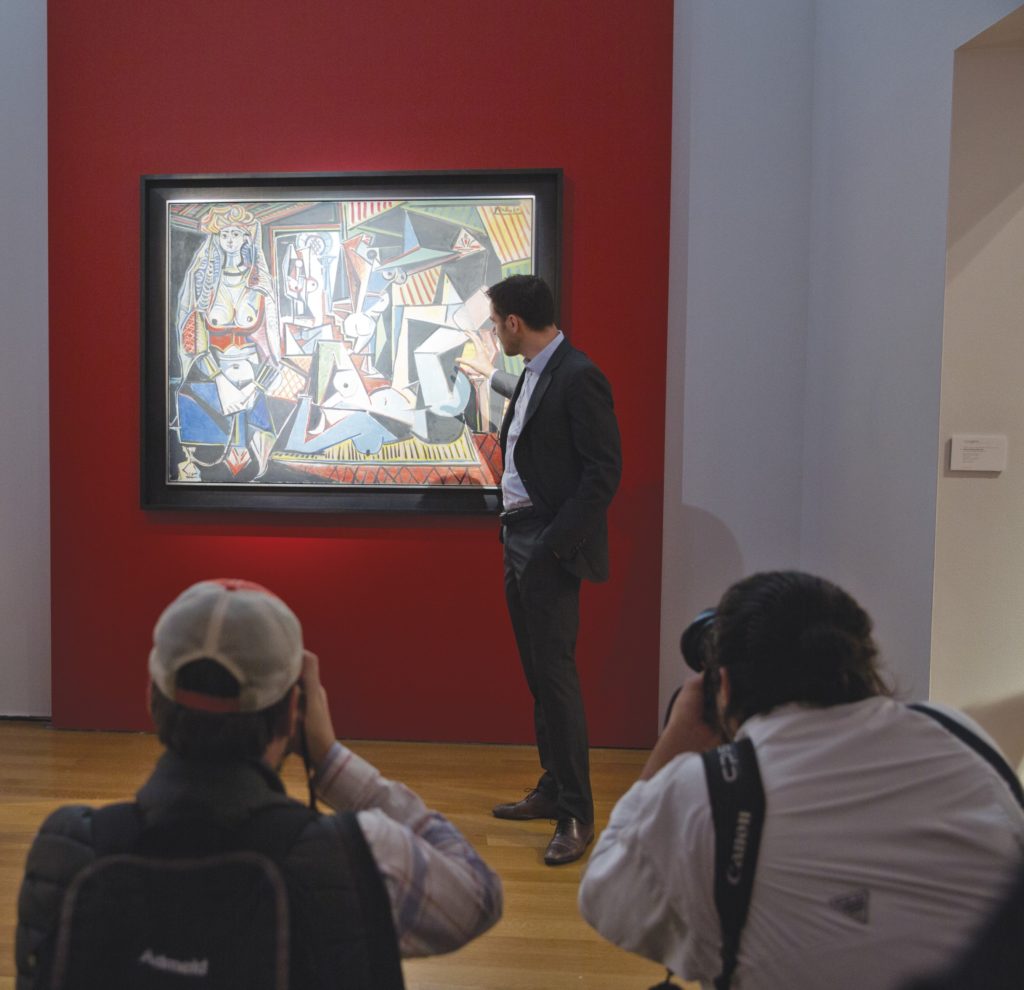
Gouzer with Picasso’s Les femmes d’Alger (Version ‘O’), 1955. Photo courtesy of Christie’s.
That auction was immensely successful, taking in $705.8 million over 35 lots, including $40.5 million for Monet’s The Houses of Parliament, at Sunset. And when the Picasso sold, it was like a firework going off over the art market. Where did you get the idea to do an auction like that?
The whole idea behind the sale, actually, came because I remember telling people a few years ago to buy Basquiat drawings because they were cheaper than Egon Schiele drawings—and then, suddenly, I realized I was telling people to buy Schieles because they were cheaper than Basquiat drawings.
As they say in France, once in a while you need to put the church back in the middle of the village—to restore things to the proper order. So I said, “It’s not normal that Warhol is more expensive than Picasso. Picasso is Picasso, and everything that’s done after is post-Picasso, or relates somehow. We have to find a Picasso that is a great Picasso, and then we can put the church back in the middle of the village.”
Then it was interesting to mix Cady Noland and Claude Monet. They don’t have much in common, but—to go back to your earlier question—I love the power of juxtaposing works that are not necessarily meant to be together, because they activate each other. I see them like molecules. And sometimes it’s bad—it’s like baking powder and vinegar, it doesn’t mix well. But sometimes you get flavors that you wouldn’t get ordinarily.
So that, in a way, made it natural to go a step further and bringing an Old Master painting into a contemporary sale. Yes, the da Vinci sale was a stunt, but the people that think that I had a very chess-like elaborate play-by-play strategy are wrong in the sense that it really came organically.
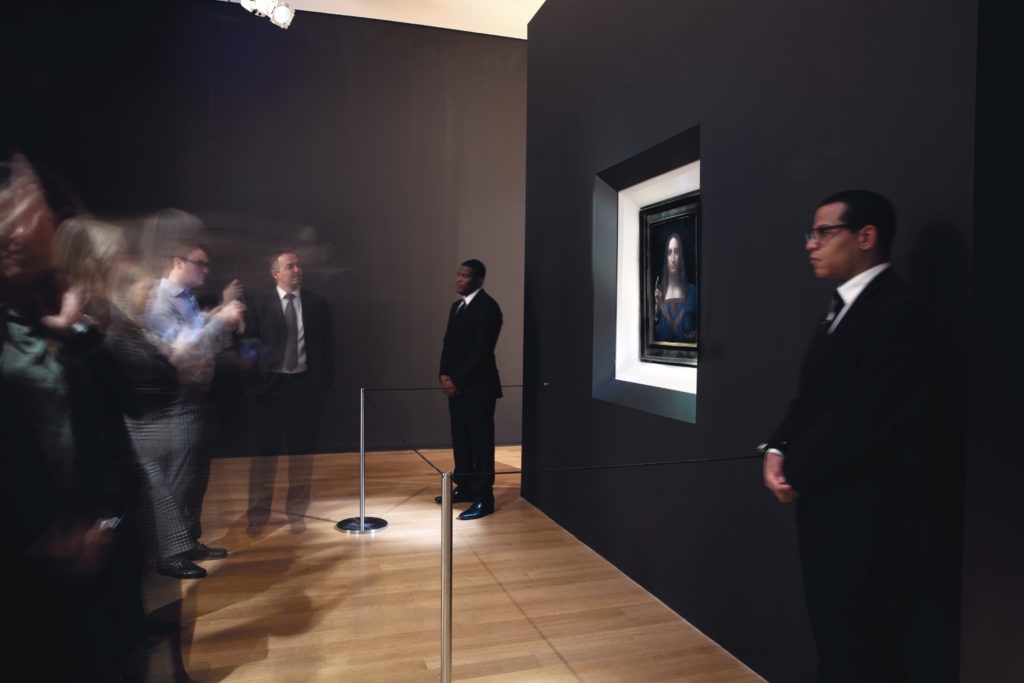
Leonardo da Vinci’s Salvator Mundi on view at Christie’s. Photo courtesy of Christie’s.
How did you go about landing the Salvator Mundi?
I knew who had it, so I played out the scenario in my head and then I went to the owner and his advisor. Everyone thought it was very much an out-there kind of idea, but they got it. Then I had to go back to Christie’s and convince Pinault and the board that this was something that we should be doing. Now, having success with sales like “Looking Forward to the Past” may have helped pave the way to get there, but that was a big stretch. By then, though, I had it all figured out in my head—how I wanted to do it, with what approach. So I managed to convince not only the seller but also everybody at Christie’s. Because when I have an idea, I can become pretty obsessive. I just think about it day and night until it happens, and I never let go.
What did you tell Dmitry Rybolovlev, the Russian billionaire who sold the painting, that convinced him to sell it with you in a contemporary auction?
I really believe in the power of surprise. Again, to go back to tennis, when Michael Chang did an underarm serve against Ivan Lendl around 25 years ago. That was the easiest shot to hit back, but Lendl lost his composure. I think that when you surprise people by doing something completely different, at first it creates a lot of chatter: “Why are they doing that? They’re crazy.” But after that moment passes, it becomes the focus of attention and creates its own buzz. With the da Vinci, everybody knew who it belonged to. It had this whole past, with the lawsuit and all that, but it just needed to be shown in a new context.
Did you ever feel any twinge of nervousness or hesitation about bringing an image of the Christian savior into the middle of the auction house, the apogee of ultra-luxe commerce? Any feeling of sacrilege?
I don’t know. I think if there’s one place where there should be a safe haven for expression, it’s museums, auction houses, galleries. And it was not first time that I’ve dealt with sensitive issues. I’ve sold [Italian artist Maurizio] Cattelan’s sculpture of Hitler, which is called Him. And I sold Richard Prince’s Spiritual America for the first time at auction [a photograph of a nude, 10-year-old Brooke Shields], which also set off a whole range of issues. I think within the art discourse people are still allowed to express or show pretty much anything, within reason.
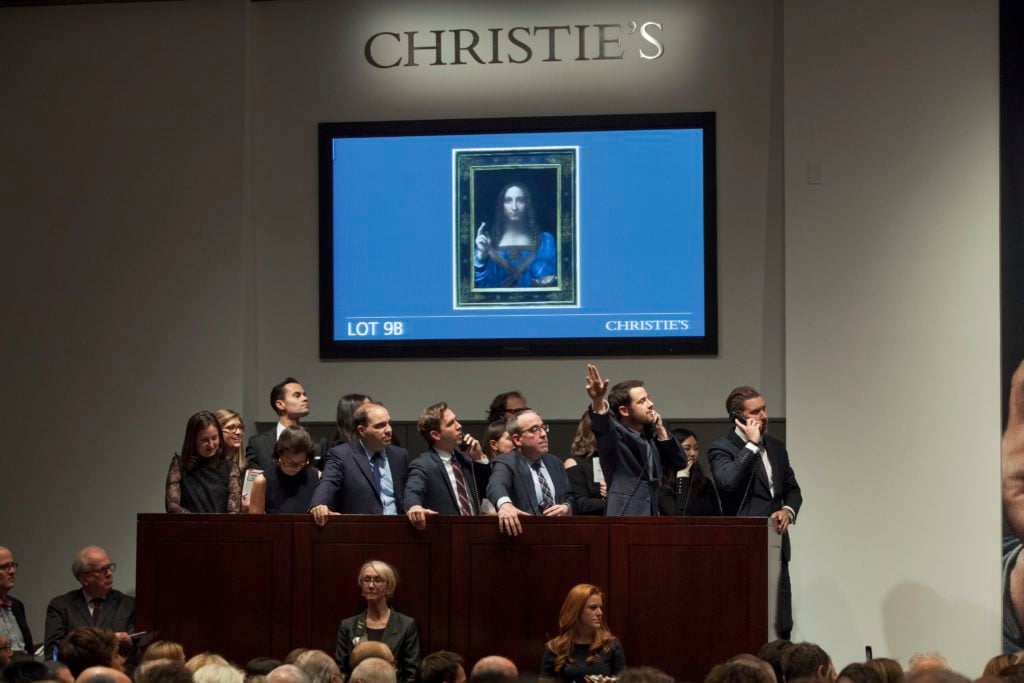
Gouzer bidding on the Salvator Mundi from the phone bank. Photo courtesy of Christie’s.
After the sale of Salvator Mundi hit the headlines, it immediately put in motion a great deal of international intrigue as one of the greatest whodunits of the art market—who was the buyer?—before finally ending up at the Louvre Abu Dhabi in the midst of a major geopolitical moment in the Middle East. Did you know who the buyer was at the time of the sale?
We knew, and we knew that the second it came out it would become big news. But while we knew ahead of the sale who would be competing against this painting, everybody was still stunned by its price. Normally everything we do stays within the realm of localized art-world news or gossip—this was on the front page of every newspaper. It made much more noise than we had expected. It also became something that had political implications that we don’t necessarily understand.
Then again, you also see that people buy art for what the object represents. Because now there’s a whole set of people who buy art for the quality of the work, but also for what it means from a cultural standpoint—how it can pretty much put a museum, a city, a country, or a region on the map. No one really knows why, but Leonardo is some kind of wizard or magician that has always mesmerized people—the first viral image-maker. The Mona Lisa was a viral image. So I expected this work to go viral as well.
Did you ever meet Saudi Crown Prince Mohammed bin Salman, who is widely understood to have been the painting’s true buyer?
That’s one thing that I can’t really go into detail about. I can’t confirm the buyers and I can’t really go into details of who I meet or don’t meet.
Fair enough. Earlier you suggested that part of the reason you’ve been incorporating Impressionist, Modern, and Old Master artworks into contemporary sales is that you feel there is some kind of imbalance in terms of the way that the market is pricing art. Do you feel that there’s some kind of imbalance in the way that art is valued?
I studied art history, and so I think when you look at something by one of the masters of Modernism, like the Malevich we sold [for $85.8 million last month], from a purely art historical point of view it should probably be worth $300 million. Because it’s foundational to all the art that we see today. Art made between 1906 and 1913 or ’14 should be, in my book, the most expensive.
Everybody has their own measure of what is most important. Some people think that a brand-new Porsche is way more important than a painting. Everybody’s opinion is as valid as the person’s next to them. But for me, the one real judge of art is time. I mean, that Malevich is fresh as hell, and even though it was painted in 1916 it could be hung next to an On Kawara and it would be perfectly fine. It doesn’t get outdated, doesn’t get outmoded. And that’s where there’s a difference between art and fashion. Great artworks are impermeable to time. That ability to retain a freshness is the number one thing I look at.
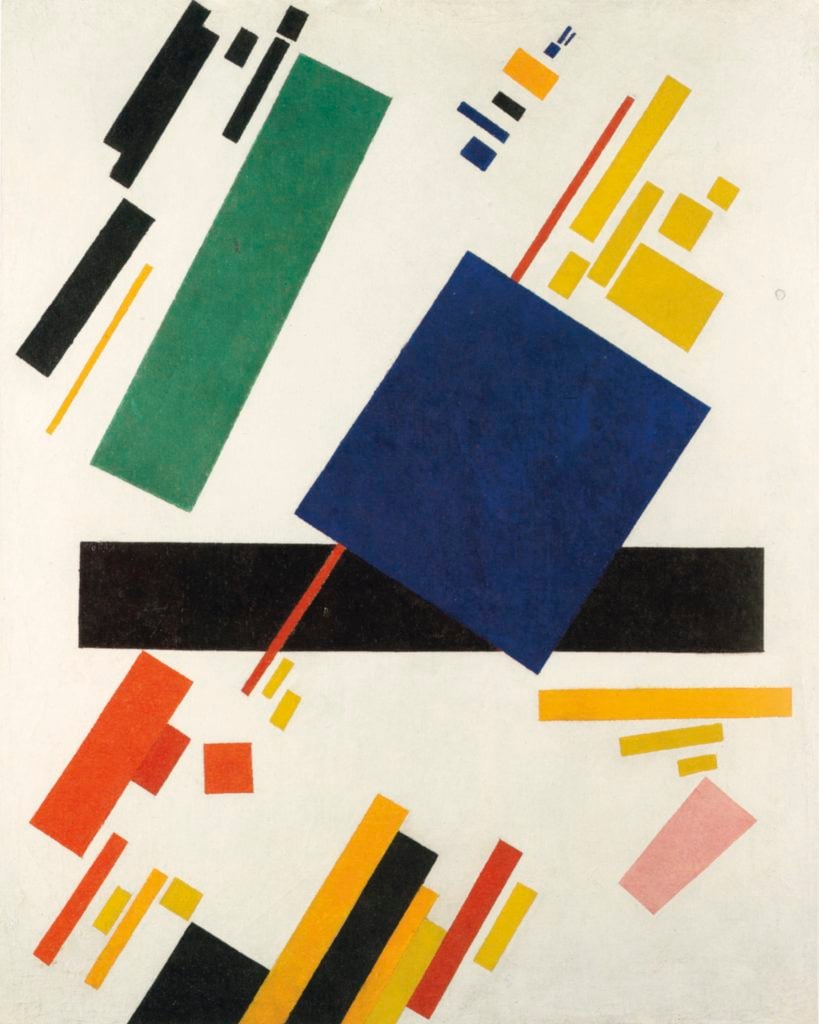
Kazimir Malevich’s
Suprematist Composition (1916) sold to Brett Gorvy for $85.8 million. Courtesy of Christie’s.
I have to ask, now that you’ve gotten halfway there already, what do you think will be the first billion-dollar artwork?
I have a few ideas, but I don’t want to put them on the record because I don’t want someone to steal my idea.
When do you think we’re going to see that new high-water mark set?
I’m sure we’ll see it one day. You know, $100 million today is much less than $100 million 10 years ago. So all of this is pretty relative.
People are realizing the power that art has. If you look at da Vinci as an example, that thing is going to attract people for years to come at the Louvre Abu Dhabi, and it’s going to help turn that museum into a cultural destination. From that point of view, maybe buying art is not necessarily so expensive. Any high-rise you walk into in New York costs more than a da Vinci; every cargo plane you see sitting around at JFK airport costs more than the da Vinci—and those are being bought and sold every day. That price lifted the cap of what paintings can sell for. I’m sure this price is going to be beaten—I don’t know when.
Do you plan on being the person to sell the first $1 billion artwork?
No, I don’t have plans that are more than six months down the road, usually. If it happens, it happens, but it’s not a goal that I have. I would be much prouder if I could raise $100 million to save an ecosystem in Indonesia. I don’t really think in terms of records. Sorry to disappoint you there.